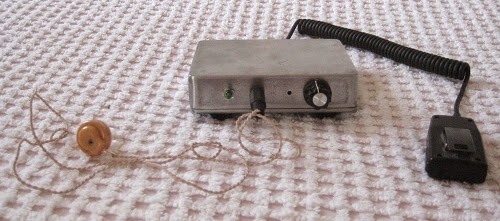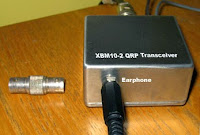Posts Tagged ‘10m’
 Tenner – a 500mW CW transceiver for 10m
Tenner – a 500mW CW transceiver for 10m
This was a rig I built and used a few years ago for 10m CW. As you can see, the design is simple but it worked across the Atlantic many times. Pull the crystal too much and the RX-TX offset becomes too great. Ideal as a simple rig for 10m CW.
 10m BitX transceiver
10m BitX transceiver
I notice that someone has created a 10m (28MHz) version of the BitX transceiver. Yes, all would like more details but we don’t know who you are!
Anonymous said: “I have successfully designed and built a 28MHz version of the BITX transceiver. The main reason for this project was to drive homebrew transverters for 6, 4 and 2Metres. Contact me if you would like details.”
 How simple?
How simple?
Some years ago I attempted to see how few components were needed to communicate on 10m. The Lesser Chirpy was the best I could manage. This was a derivative of The Chirpy, which worked, but had far too much chirp!
Looking at the circuit I see I could save 1 component by replacing C1 and C2 by preset C’s and shorting out C3. This would allow the TX-RX offset to be set. If one was made a variable rather than a preset the RX-TX offset could be adjustable.
Since being ill I have not tried the rig. A limitation was the limited RX sensitivity, meaning only stronger stations would be workable. However, the rig does work and is very simple. Another possibility is to switch to an external RX but allow the internal RX to be used when signals are strong enough. The TX power is certainly enough to span the Atlantic and work all over Europe.
The secret to low chirp on 10m is the use of FSK rather than CW. Essentially the TX changes frequency rather than go from RX to TX every time. This means full break-in is not possible in such a simple circuit. Can you do better? If so, I’d love to see the schematic please. I make no great claims for my circuit, which is an amalgam of ideas. Pure fun!
 10m antennas
10m antennas
As you will have noticed by now, 10m is one of my favourite bands. Although quiet at many times in the solar cycle it always comes to life with Es from late April until September. Alert 10m operators will sniff out Es at other times too, but there may be long periods of noise, as on 6m. WSPR is an ideal mode when the band may otherwise seem quiet. It is good for local nattering at any time and F2 N-S DX is often there even at solar minima. Antennas for the band are small and easy to make such as the design on my website for a 10m halo. See https://sites.google.com/site/g3xbmqrp3/ .
A video of K7AGE making a dipole for 10m is available at YouTube. See https://youtu.be/84F4UgSWmQo. In this video, Randy is making a dipole for the USA technician’s band, so to cover the main SSB band (28.4 to 28.6MHz) you will need to make the wire slightly shorter. In my experience if you cut the wires for the centre of the band it will still have a pretty low SWR at the band edges. Even a very simple ATU will bring the SWR down to 1:1, although unless your rig has a problem with a mismatch of around 1.8:1, I would not bother, as the difference in radiated power is negligible (fraction of an S-point).
Because of the short wavelength, 10m antennas don’t have to be that high to be effective. When the band is in good shape, worldwide DX can be had with simple wire antennas and low power. It is a rewarding band. What is more, 10m multi-mode transceivers can be bought at low cost. In summary, 10m is unique: low cost transceivers, simple antennas and good DX potential.
 Sixbox QRP rig for 6m
Sixbox QRP rig for 6m
 |
| Sixbox 6m AM rig – a simple design |
Several years ago I designed and built a derivative of my 2m Fredbox but for 6m AM. The same basic design would easily translate to a 10m version. Both bands could be useful for cross-town natters, especially when both 10m and 6m behave like VHF bands, which is in the quieter sun years and at night on 10m. The Sixbox is simple and certainly capable of further development.
Treat the design as a starting point. A 10m version of the RX has copied transatlantic USA AM stations well, but this is NOT a rig for DX use. It is better suited to cross-town/inter-village natters.
 HF or VHF?
HF or VHF?
Depending on the solar cycle, and how good it is, both 10m and 6m can behave quite differently. Sometimes 10m is a true HF band with good worldwide DX possibilities. In better years, even 6m can support F2 worldwide propagation. However, for a lot of the solar cycle both 10m and 6m behave like VHF bands. This means Es can be an effective mode on both bands especially in the spring and summer months. Other modes like tropo can also be used on 10m and 6m. Both bands can be used for local natters on any mode.
At the moment we are in a transition period. On better days 10m is still good for worldwide DX but as time progresses, it will behave more and more like a VHF band with long periods of quiet. Especially as we move to more VHF conditions modes like WSPR become even more useful: short DX openings can be detected with WSPR. Leaving a simple WSPR rig running can be so useful and take very little power.
As I have mentioned before, I have worked real 10m N-S DX (11000+ km) on QRP SSB even in the quietest of sunspot years. WSPR is considerably better than SSB, requiring far less power and can be used unattended running in the background. I tend to run 10m and 6m WSPR most days and monitor WSPRnet on a different PC in the lounge. It takes just seconds to go into the shack and make any adjustments needed. It means, whilst running WSPR, you can do other things.
 Changing propagation
Changing propagation
If proof were needed that we are now on the way down to the next minimum then take a look at the sunspot number graphs at http://www.solen.info/solar/ .
Although conditions are sliding, do not abandon the higher HF bands like 10m. There is (usually) quite a lot of good DX around still. In the last solar minimum I was still able to work well into southern South America on 10m with QRP SSB. WSPR should be even more reliable when conditions are edgy.
I really do hope a strong core of WSPR operators stick with 10m as, in many ways, in the poorer times are when WSPR will be most valuable as a tool. I am hoping that when not on traditional modes like SSB or CW people will still WSPR so we can catch fleeting openings, which are probably far more common than people expect on 10m. Remember, the F2 or transequatorial propagation has only to go above 28.126MHz for 120 seconds and someone on WSPR may spot it!














